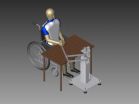(Press-News.org) Oxford, October 8, 2012 - A nanotech material containing an extract from liquorice can be used to sterilize and protect medical devices and implants which include biological components, and protects these functional bio-components during the sterilization process.
Publishing their findings in the latest issue of Materials Today, a team of researchers from Germany and Austria explain how conventional sterilization techniques based on a blast of radiation, or exposure to toxic gas can damage the functional biological components of the device. The coating, containing a component found in liquorice and developed by German biotech company LEUKOCARE AG, protects these sensitive components.
Joachim Koch of the Georg-Speyer Haus, Institute for Biomedical Research in Frankfurt am Main in Germany and colleagues explain how medical devices and implants are increasingly functionalized using pharmacologically active proteins, antibodies and other biomolecules. Harsh sterilization procedures, including beta and gamma irradiation or exposure to toxic ethylene oxide can damage these sensitive molecules and render the device useless. However, without sterilization the patient is at risk of infection when the device is used or implanted.
The team has now successfully evaluated the nano-coating; a technology which employs a composition of stabilizing nano-molecules. One important ingredient is a compound known as glycyrrhizic acid, a natural, sweet-tasting chemical found in liquorice. Unlike other stabilizing approaches used in biopharmaceutical formulations, the nano-coating contains no sugars, sugar-alcohol compounds or proteins that might otherwise interfere with the biological activity of the device.
The team has tested the nano-coating by coupling and stabilizing an anti-inflammatory antibody to a porous polyurethane surface. This carrier acts as a surrogate for a medical device. Such a system might be used as a therapeutic implant to reduce inflammation caused by an overactive immune system in severely ill patients. The researchers found that even if the test device is blasted with radiation to sterilize it entirely, neither the nano-coating nor the proteins are damaged by the radiation and the activity of the device is maintained.
"This nano-coating formulation can now be applied for the production of improved biofunctionalized medical devices such as bone implants, vascular stents, and wound dressings and will ease the application of biomedical combination products," Koch explains.
###
Notes to editors
This article is "Nano-coating protects biofunctional materials" by Rupert Tscheliessnig, Martin Zornig, Eva M. Herzig, Katharina Luckerath, Jens Altrichter, Kristina Kemter, Adnana Paunel-Gorgulu, Tim Logters, Joachim Windolf, Silvia Pabisch, Jindrich Cinatl, Holger F. Rabenau, Alois Jungbauer, Peter Muller-Buschbaum, Martin Scholz, and Joachim Koch (DOI: 10.1016/S1369-7021(12)70166-9) .The article appears in Materials Today, Volume 15, Issue 9, Page 394 (2012) published by Elsevier.
Full text of the article is freely available from here. Journalists wishing to interview the authors may contact Dr. Stewart Bland at +44 1865 84 3124 or s.bland@elsevier.com
About Materials Today
Materials Today is the Gateway to Materials Science and home of the Open Access Journal of the same name. The journal publishes peer-refereed review and research articles that assess the latest findings and examine the future challenges, as well as comment and opinion pieces from leading scientists discussing issues at the forefront of materials science. Visit http://www.materialstoday.com for access. Beyond the journal, Materials Today also publishes news, interviews, educational webinars, jobs and events; and provides free access to a range of specially selected articles from Elsevier's materials science journals. For more information on all aspects of Materials Today, including the editorial calendar and advertising options, contact the editor, Dr. Stewart Bland at s.bland@elsevier.com. Follow @MaterialsToday on Twitter; and on Facebook: http://www.facebook.com/elsevier.materials.
About Elsevier
Elsevier is a world-leading provider of scientific, technical and medical information products and services. The company works in partnership with the global science and health communities to publish more than 2,000 journals, including The Lancet and Cell, and close to 20,000 book titles, including major reference works from Mosby and Saunders. Elsevier's online solutions include ScienceDirect, Scopus, Reaxys, ClinicalKey and Mosby's Nursing Suite, which enhance the productivity of science and health professionals, and the SciVal suite and MEDai's Pinpoint Review, which help research and health care institutions deliver better outcomes more cost-effectively.
A global business headquartered in Amsterdam, Elsevier employs 7,000 people worldwide. The company is part of Reed Elsevier Group PLC, a world-leading publisher and information provider, which is jointly owned by Reed Elsevier PLC and Reed Elsevier NV. The ticker symbols are REN (Euronext Amsterdam), REL (London Stock Exchange), RUK and ENL (New York Stock Exchange).
Media contact
Stewart Bland
Elsevier
+44 1865 84 3124
s.bland@elsevier.com
Liquorice offers clue to cleaner medical implants
A new coating utilizing nanotechnology will allow surgeons to sterilize medical devices that contain biological components
2012-10-09
ELSE PRESS RELEASES FROM THIS DATE:
New methods might drastically reduce the costs of investigating polluted sites
2012-10-09
This press release is available in German.Ferrara/Leipzig. New methods might allow polluted sites to be investigated and monitored long term at significantly reduced costs. Authorities and those who have to remediate polluted sites in Europe might therefore be able to save costs and use these to treat other areas. This is the conclusion of the EU research project ModelPROBE, which was coordinated by the UFZ. The results, with which the scientists aimed to lower the workload of authorities and consultants, include a handbook detailing the methods for characterising contaminated ...
Worldwide patent for a Spanish stroke rehabilitation robot
2012-10-09
VIDEO:
This is about the worldwide patent for a Spanish stroke rehabilitation robot.
Click here for more information.
Robotherapist 3D, a robot which aids stroke patients' recovery, is to be brought to market by its worldwide patent holder, a spin-off company from the Miguel Hernández University of Elche (Alicante, Spain). It is the first robot to enable patients to start doing exercises while supine, allowing them to begin shortly after the stroke and expediting recovery. ...
River Thames invaded with foreign species
2012-10-09
Almost 100 freshwater species not native to the UK have invaded the River Thames catchment making it one of the most highly invaded freshwater systems in the world, according to scientists at Queen Mary, University of London.
The research, published in the journal Biological Invasions at the weekend, suggests that legislation to prevent the introduction of non-native species across the UK has been unsuccessful. The cost to the British economy of invasive non-native species is £1.7bn every year (CABI report, 2010).
Lead author, Dr Michelle Jackson* who undertook the ...
VIB concludes that Séralini study is not substantiated
2012-10-09
The scientific analysis in this document shows that the research design of Séralini et al. contained fundamental shortcomings that preclude any sensible conclusions from being drawn. In other words, the statements that Séralini made about the health effects of GMOs and Roundup were baseless. Moreover, the research shows signs of selective interpretation of the findings or a misleading representation of these, which is contrary to prevailing scientific ethical standards.
###View the entire analysis online: http://www.vib.be/en/news/Pages/VIB-concludes-that-Seralini-study-is-not-substantiated-.aspx
...
A system to automate traffic fines is designed
2012-10-09
This press release is available in Spanish. The goal of the scientists in the Information and Communications Technology Security Group (Seguridad de las Tecnologías de la Información y las Comunicaciones - SeTI) at UC3M who are working on the E-SAVE project is to use information technologies (ITs) to improve the enforcement of certain traffic regulations. Specifically, they propose a set of systems for the automated, immediate and telematic supervision and management of the administrative sanctioning process. The purpose is to reduce highway accidents, given that one of ...
Researchers develop new way to determine amount of charge remaining in battery
2012-10-09
Researchers from North Carolina State University have developed a new technique that allows users to better determine the amount of charge remaining in a battery in real time. That's good news for electric vehicle drivers, since it gives them a better idea of when their car may run out of juice.
The research is also good news for battery developers. "This improved accuracy will also give us additional insight into the dynamics of the battery, which we can use to develop techniques that will lead to more efficient battery management," says Dr. Mo-Yuen Chow, a professor ...
UC research finds small signs lead to big frustrations
2012-10-09
Signs that are too small or unclear to consumers seem to be a growing national issue, leading some business owners to lose potential customers, according to University of Cincinnati Marketing Professor James Kellaris.
"This persistent, growing national problem is frustrating for consumers and can lead to loss of business and, by extension, loss of tax revenue for the community," Kellaris said.
Kellaris, the James S. Womack/Gemini Chair of Signage and Visual Marketing in the UC Carl H. Lindner College of Business, will present this research during the October 10 -11 ...
Cause of annoyance, concern, anxiety, and even anger:
2012-10-09
To understand the effects of continuous computerized surveillance on individuals, a Finnish research group instrumented ten Finnish households with video cameras, microphones, and logging software for personal computers, wireless networks, smartphones, TVs, and DVDs. The twelve participants filled monthly questionnaires to report on stress levels and were interviewed at six and twelve months. The study was carried out by Helsinki Institute for Information Technology HIIT, a joint research institute of Aalto University and the University of Helsinki, Finland.
The results ...
Southampton researchers explain how pulsars slow down with age
2012-10-09
Researchers at the University of Southampton have developed a model which explains how the spin of a pulsar slows down as the star gets older.
A pulsar is a highly magnetised rotating neutron star which was formed from the remains of a supernova – an explosion which happens after a massive star runs out of nuclear fuel. A pulsar emits a rotating beam of electromagnetic radiation, rather like that of a lighthouse. This beam can be detected by powerful telescopes when it points towards and sweeps past the Earth.
Pulsars rotate at very stable speeds, but slow down as ...
Researchers examine how teachers can increase students' interest and engagement in the classroom
2012-10-09
The National Center for Educational Statistics reported that only 73% of high school freshmen graduate within four years. For those students who continue their education at the collegiate level, slightly more than half (57%) earn a bachelor's degree and over 18% will leave college altogether. Although many factors can contribute to students' academic risk, negative emotions associated with learning—such as a lack of interest and engagement in their courses—could be a vital reason for students' disengagement, withdrawal, and failure in school.
Joseph Mazer's article, published ...
LAST 30 PRESS RELEASES:
Making lighter work of calculating fluid and heat flow
Normalizing blood sugar can halve heart attack risk
Lowering blood sugar cuts heart attack risk in people with prediabetes
Study links genetic variants to risk of blinding eye disease in premature infants
Non-opioid ‘pain sponge’ therapy halts cartilage degeneration and relieves chronic pain
AI can pick up cultural values by mimicking how kids learn
China’s ecological redlines offer fast track to 30 x 30 global conservation goal
Invisible indoor threats: emerging household contaminants and their growing risks to human health
Adding antibody treatment to chemo boosts outcomes for children with rare cancer
Germline pathogenic variants among women without a history of breast cancer
Tanning beds triple melanoma risk, potentially causing broad DNA damage
Unique bond identified as key to viral infection speed
Indoor tanning makes youthful skin much older on a genetic level
Mouse model sheds new light on the causes and potential solutions to human GI problems linked to muscular dystrophy
The Journal of Nuclear Medicine ahead-of-print tip sheet: December 12, 2025
Smarter tools for peering into the microscopic world
Applications open for funding to conduct research in the Kinsey Institute archives
Global measure underestimates the severity of food insecurity
Child survivors of critical illness are missing out on timely follow up care
Risk-based vs annual breast cancer screening / the WISDOM randomized clinical trial
University of Toronto launches Electric Vehicle Innovation Ontario to accelerate advanced EV technologies and build Canada’s innovation advantage
Early relapse predicts poor outcomes in aggressive blood cancer
American College of Lifestyle Medicine applauds two CMS models aligned with lifestyle medicine practice and reimbursement
Clinical trial finds cannabis use not a barrier to quitting nicotine vaping
Supplemental nutrition assistance program policies and food insecurity
Switching immune cells to “night mode” could limit damage after a heart attack, study suggests
URI-based Global RIghts Project report spotlights continued troubling trends in worldwide inhumane treatment
Neutrophils are less aggressive at night, explaining why nighttime heart attacks cause less damage than daytime events
Menopausal hormone therapy may not pose breast cancer risk for women with BRCA mutations
Mobile health tool may improve quality of life for adolescent and young adult breast cancer survivors
[Press-News.org] Liquorice offers clue to cleaner medical implantsA new coating utilizing nanotechnology will allow surgeons to sterilize medical devices that contain biological components


